|
Last week PetFoodIndustry.com published a blog post, "Simple, clean pet food labels: altering the discussion." The very premise of the article is quite ironic: consumer perception is the problem, not the pet foods. It's not that consumers are becoming better educated as to what provides the best promise of long term health to their animal companions. No, on the contrary, the "problem" is the failure of the pet food industry to properly educate the consumer about the existing ingredients in pet foods. After all, pet food is all about the science of nutrition. And, you know, "science is hard." The author asks "So, what is driving this clean label trend?" and answers: "Like many things, it is consumer demand, driven by perception. In this case, it is backed by nutritionists who agree that eating a diet made up of whole, unprocessed foods such as fruits and vegetables is better for our health. So, consumers will be compelled to read the labels of processed foods, looking for something that is as close to the original state as possible, but with the convenience of a packaged food." Consumer demand. Driven by perception. Backed by nutritionists who agree that eating a diet made up of whole, unprocessed foods is better for our health. Well, consider substituting "education" for "perception" and "Informed by" for "backed by" and see what happens. The concept then reads "Like many things, it is consumer demand, driven by education. In this case, it is informed by nutritionists who agree that eating a diet made of of whole, unprocessed foods ... is better for our health." Is this a bad thing, pet parents wanting to provide their pets healthy, whole foods? Well, if you are Mars, Nestlé, or Del Monte (with what has been renamed the Big Heart Pet Brands) - the largest pet food companies in the world - the knowledge that a solely processed food diet isn't healthy for us or our pets is a bad thing. As they are all also among the largest food and beverage companies in the world, of course they want to counter the notion that homemade and fresh foods are the best foods for us - and our pets. But if it is science they want, there is a growing body of it. Just a few weeks ago, a team of Australians from the Charles Perkins Centre and School of Life and Environmental Sciences at The University of Sydney published a report, Nutrition Ecology and Human Health. The message of the report is straightforward: nutrition science is broken. In a nutshell, while focusing on micronutrients had its place in our understanding of the importance of diet in combating disease, that nutritional model that breaks down nutrition into its components is fundamentally incompatible with the "new suite of nutrition-related diseases." "Food science" isn't failing just human health. There is - sadly - plenty of evidence the same holds true for our pets. As mentioned in our article, Cat Food vs. Cat Health, it is a relatively recent situation that approximately 60% of pet cats in the U.S. live indoor-only. This means that our little predators are not out hunting field mice, voles, rats, or rabbits. They have become completely dependent on us for their nutritional needs. What this also means is that health problems associated with the typical commercial diet are becoming ever more apparent, especially as access to veterinary care and safety from cars and predators contributes to their longer lives. Our cats are overweight, blocking from crystals in their urine, suffering dental disease, and GI disorders are rising at alarming rates, with the incidence of inflammatory bowel disease and pancreatitis now making the "Top Ten" lists of VPI Pet Insurance. Our cats are dying primarily of kidney disease and cancer. Surely food alone does not account for all of these problems. But at Food Fur Life we ask, how healthy would we be if all we ate was dry cereal and/or canned stew – all made with ingredients that weren’t fit for our consumption? No, Pet Food Industry, the problem is not lack of consumer education as to the "safety" of the ingredients in the diets you provide. Your problem is consumers are learning their carnivorous pets need whole, fresh, quality, species-appropriate foods for their best health, too. This is why we created Food Fur Life - to make healthy homemade food accessible to everyone. To make it easy for the busiest of pet parents to provide their pets a fresh, truly human-grade meat-based diet based on the prey model. Blending the best of mother nature and science, whether pet parents are time constrained, and feel they don't have the time to make their own pet food all from scratch, or whether there is concern about "doing it right," we have the solution. And it really is EZ, with EZcomplete.
0 Comments
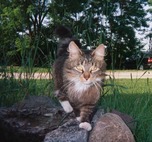
(Laurie here)
I don’t know about you, but our very first cat adopted us. She let us think we chose to feed her, that skinny, matted stray raiding the garbage. And it was a triumph when after months Booger allowed us to groom her. Of course we let her in when she decided our home was hers! ...Of course, we also let her back out when the thunderstorm passed. She insisted. Loudly. 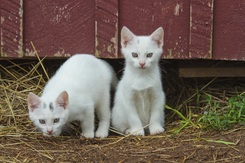
Given the first records of the domestication of cats dates back to when humans were first settling down to farm, it’s easy to imagine both human and cat enjoying the benefits of proximity, isn’t it? They’re magical, entertaining creatures, cats are. And they protected the farmers’ grain stores from rodents. It was a win-win! We’ve been companions ever since. Cats traveled the globe with us. Literally, as it turns out.
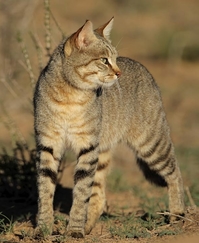
It came as quite the surprise when a research team led by geneticist Carlos Driscoll of the National Cancer Institute and scientists at the University of Oxford in England decided to trace the origin of domestic cats – and found that every single one of the 979 cats included in the project from around the world were “virtually indistinguishable” from the African Wildcat at the genetic level. That’s right, that purring, kneading bundle of soft, silky fur, born under different circumstances, could be just as at home stalking prey on the great plains of South Africa.
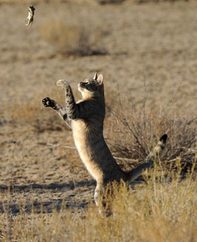
Many assume the influence of living among humans would have had an impact on what cats have the ability to eat and use for sources of energy and nutrition, as appears to the be case for dogs. Nope. Not so. Not at all. Despite their proximity to humans for at least 10,000 years, cats retain their unique anatomic, physiologic, metabolic, and behavioral adaptations consistent with eating a strictly carnivorous diet. That is to say that cats, to this very day, remain obligate carnivores. By their genetic makeup, cats must eat the tissue of other animals in order to thrive.
Our kitties delight us with their playful antics well into old age. And as we’ve brought our cats indoors full-time, we find that to keep them happy and fit, we have to engage them in interactive play. What we are witnessing is their prey drive. That seemingly kitten-like, playful behavior we enjoy from birth to death in our furry friends is unique to cats: their prey drive is not dependent on hunger. They are so hard-wired to hunt and engage prey, they don’t need to be hungry to “play.” 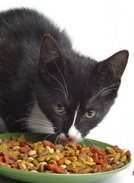
In fact, cats are such highly specialized hunters it is absolutely critical to their long term health that we understand cats are a metabolically inflexible carnivore. What does that mean? Well let’s find out.
Since moving indoors full-time and becoming completely dependent on us for food, what has happened? We need convenient food with our busy lifestyles. And most of us do not intuitively understand what cats need – they seem like little aliens to us. They certainly did to me. We ask our vets. And many of our vets tell us that for dental health, cats need kibble, that to mimic their "natural" pattern of eating many small meals (being hunters of small mammals), we should leave the food out. We didn't know any better, and we trusted our vet to know what’s best for Booger. Or we free-feed kibble to our kitties, because that’s what and how our parents fed our cats when we were growing up. So 80% of us go to the store and buy a bag of kibble, come home, and pour it into a dish we keep full for Boots, and Socks, and Tigger. …except cats evolved eating moisture-rich food in the desert. Kibble has virtually no moisture – and cats do not have a thirst-drive that keeps them properly hydrated. This is a clash of momentous impact: The number one reason for a vet visit by cats is bladder or urinary tract problems – usually crystals and life-taking or life-threatening urinary tract blockages –problems that need not exist if we feed a moisture-rich, fresh meat-based diet. Cats, not designed to use all those carbs, grains, or starches in their food, not designed to derive needed protein from non-meat-based sources, experience kidney disease at a rate of seven times more than dogs. And our kibble fed cats, chronically dehydrated, die most frequently from kidney disease, the number one cause of death in cats over the age of five. Yet in the face of this, many of our vets STILL tell us our cats need to eat some kibble for dental health. But 85% of cats over the age of three years have dental disease. What the…. ????? How can they not notice this dichotomy? So we put down that bowl of kibble for kitty to “graze.” Except cats aren’t herbivores. Cats shouldn’t graze. Allowing cats to graze has resulted in a problem of “epidemic proportions." 58% of our cats are either overweight or obese – an increase of 90% over the past five years. So now we have fat cats. And that means that 67% of our cats have arthritis. And being fat increases the risk of diabetes by 300% - 500% - so it’s shouldn’t be surprising that the incidence of diabetes in our cats has DOUBLED in the past five years. 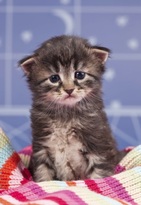
In fact, THREE of the top 10 reasons for vet visits by cats in the past several years are related to digestion. Our cats suffer chronic vomiting, diarrhea, and now full-blown Inflammatory Bowel Disease.
Are you crying yet? At Food Fur Life, we are. What are we doing to our cats? How has this happened? Pet food marketing and lack of industry regulation or real oversight. As outlined above, the problems seem as if they are related to only kibble. But no, the problems are not limited to just kibble. Moisture-depleted, ultra-processed crunchy food made from rendered ingredients is certainly more problematic than canned or pouched cat food. Species-inappropriate ingredients are most certainly a culprit: forcing our cats to eat what nature didn't build them to use as a source of nutrition or energy clearly has a hand in our cats' health problems. But the issues extend far beyond processing and non-meat-based ingredients in our cats' food. That said, issues with ingredient quality (despite the marketing that would have us believe otherwise even in expensive foods) and the use of additives and diseased animals (even in canned food) with most canned and kibble commercial cat foods are beyond the scope of this post. The problems are staggering and seem almost unbelievable when we first start learning about them. Ann Martin describes them in her book, Foods Pets Die For: Shocking Facts about Pet Food. Dr. Elizabeth Hodgkins, former Director of Technical Affairs at Hill’s Pet Nutrition, co-authored the book Not Fit for a Dog: The Truth About Manufactured Pet Food. And Carolina and I got our first introduction to the problems in the pet food industry with a paper written by a Harvard Law student, “Deconstructing the Regulatory Façade: Why Confused Consumers Feed their Pets Ring Dings and Krispy Kremes.” Bottom line? The health problems sooooo many of our pets are experiencing are DIRECTLY related to the diet we feed them. And we can change that.
Fresh Food for Our Cats: It’s Just Common Sense!
We have been told that feeding a fresh meat-based diet to our cats is dangerous. Of course, many veterinarians do support the idea of feeding our cats a species-appropriate, fresh meat-based diet – in theory. Seeing the impact of improperly made homemade diets, many vets are fearful of recommending it, and understandably so. But with the advent of commercially available balanced raw foods for cats, and with a supplement like EZcomplete fur Cats that makes it so easy to provide complete and balanced homemade food – what’s stopping us? Think of a fresh food diet for our cats like this. As the title to this section says, it just takes a bit of common sense. How old is your cat? Three years? Five? Seven? Nine? Eleven? At three years old, your cat is the equivalent of 28 human years. At five, your kitty is the equivalent of 36; At seven, your cat is the equivalent of 44; At nine, that is an equivalent of 52; At 11, your kitty is the equivalent of 60 human years. Even if you don’t eat the healthiest diet, can you imagine never – never, ever – having eaten an apple? An orange? A salad? for 28 years or 36 years or 44 years or 52 years - or for 60 years? That's what we are doing to our cats by never, ever feeding them any fresh meat (which is not a balanced diet) EVER. And I'm not talking about the slice of deli ham that Bella stole, or the bit of barbequed steak that dad slipped to Muffin. I mean fresh, raw meat. A slice of chicken breast. A bite of chicken liver. Yeah - it takes more work than that to make a balanced diet. But don't you feed your kitty treats? We don't worry those are going to cause their diet to become unbalanced. There's no reason not to slice off a bite of chicken breast before you season it and bake it, the next time you're cooking chicken for dinner, and offer that to Smokey as a treat instead that stuff in a bag or bottle. Got another one for you. Pretend you’re an astronaut, and have been on the space station for nine months. All you’ve eaten is food squished out of a packet. When you land, what are you craving? Dry cereal? Canned stew? Probably not. Our doctors, our government tell us that we need to eat fresh food. We need 2-4 servings of fresh fruit per day. We are advised to eat 3-5 servings of fresh vegetables each day. And yet we expect our cats, designed to derive ALL of their needed nutrition from ONLY small animals, to thrive on the most highly processed food there is, full of carbohydrates. And even if “real meat” is advertised as the number one ingredient in that food, the moisture was sucked out of it before it gets to your cat. Even many canned foods highlight their inclusion of "healthy" peas and carrots, cranberries or blueberries, or that they include corn gluten meal to reduce their urine pH. Ummmm... did we forget? Cats aren’t out there eating the grain stores of farmers. They eat the mice that eat the grain. Cats aren’t out there raiding the vegetable garden. They eat the rabbits that raid our gardens. Cats aren't out there snacking on blueberries. They eat the birds that eat the berries. Cats aren’t out there roasting their mice, either. In fact, a 2008 review of research on pancreatitis in cats by Texas A&M noted a study where post-mortem biopsy of 115 cats (both sick and healthy cats) discovered findings consistent with chronic pancreatitis in 67% of the cats – including 45% of “apparently healthy” cats. Please read that again. Is your mind blown? If not, read it one more time, please. Dr. Jean Hofve, in her article on the importance of enzymes, published in IVC Journal, shares why that may be. Cooking food kills the naturally occurring enzymes that aid digestion. Many of our cats may literally be suffering from eating cooked, highly processed foods, as pancreatitis, in 2015, made the Top 10 list of health insurance claims. What Happens When We Feed Our Cats A Balanced Raw Food Diet? So what happens when we feed our cats a diet modeled on the food they are meant to eat? When we employ a little common sense, and realize that if we thrive on fresh, whole foods, our cats will also thrive on their equivalent – a fresh, properly balanced, animal tissue-based diet?
Raw feeders also report less shedding, behavior changes (aren’t you less grumpy when you eat fresh foods vs when you’ve been on a carb or sugar binge?), more energy (yes, you will have to play with your cats more!), a cessation of itching and overgrooming – and even improvements in asthma. Mother Nature Knows What Cats Need WHY do we think we need to “improve” upon the diet cats are born to eat? WHY do we need studies that show us cats *can* eat grains, starches, pulses, and legumes? That cats *can* eat plant-based proteins or derive some energy from carbs SHOULD be moot. If we put diesel oil into our gas-powered cars, should we expect them to run properly? No, feeding a balanced raw diet doesn’t cure everything. But when we get over our fears and feed our cats a balanced diet featuring food their bodies NEED, we rapidly see the changes. Yes, rapidly. Often it seems like magic. Of course, the longer the problem has occurred, the more time it can take to resolve. Sometimes there is significant damage. Fortunately, for many cats like Carolina's Bugsy, all they need is raw food. Bugsy had 14 months of diarrhea (despite following veterinary advice and protocols), and it immediately cleared up after eating his first meal of 100% raw food. That journey is recorded here. Problems we took for granted as being “that’s just my cat” go away. Yes, it is a lifestyle change. To continue to reap the benefits for the furry members of our family, we need to continue to feed them like the cats they are. And we SEE the difference between our cats just surviving – and our cats truly thriving. Of course, at Food Fur Life, we help make feeding your cat a complete & balanced, healthy, fresh, raw meat-based diet quick, easy and convenient. Buy meat. Add supplement and water. Feed Cat. It really couldn't be easier than with EZcomplete fur Cats. ...and these are happy tears. No more pancreatitis! 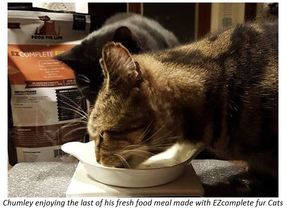
Pet food industry data is quite clear - Americans want healthier food for their pets. According to GfK, retail sales of raw freeze-dried foods for cats and dogs jumped 64% from $25 million to $40 million, and sales of raw frozen pet food jumped 32% from $52 million to $69 million last year. And it is pet parents driving - demanding - the change. Allprovide, a raw pet food company in Norcross, GA, conducted a survey of cat and dog owners across the U.S. on their pet food preferences, knowledge and interests. 1,826 owners were polled, and according to the company, the results show that "more than 37% of pet owners are interested in a fresh, healthy raw food diet for their pets," and an astounding 55% of pet parents would prefer to give their pets fresh food that can be served naturally or cooked. !!!!!!!! The full results of the study show:
Labeled the "natural food craze" and reduced to the "humanization of pets" by Pet Food Industry articles, with allergies, diabetes (in cats), ear & skin infections, lower urinary tract problems/bladder infections, diarrhea/vomiting/intestinal upset - and in cats, inflammatory bowel disease and/or pancreatitisamong the top 10 reasons for vet visits by cats and dogs is it ANY wonder pet owners want to feed their pets FRESH meat-based, grain- and filler-free foods? Foods on which these species have thrived through millennia? In fact - the evolutionary diet on which they thrived until they moved inside and became dependent on us. With research in human health linking processed foods to the development of autoimmune disease, we consider the desire to feed minimally processed foods to our pets as well as to our families simply common sense. |
Archives
August 2021
Categories
All

|
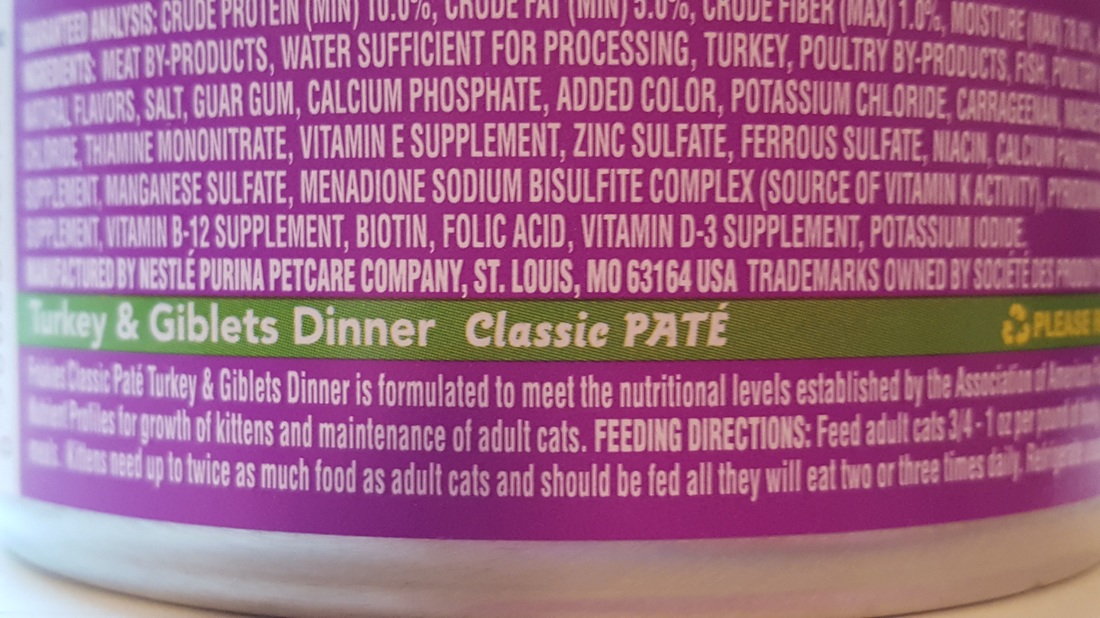



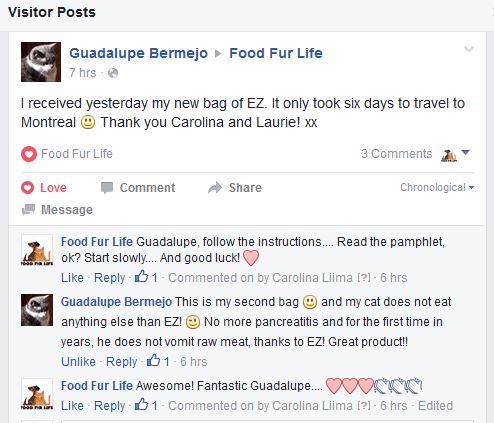
 RSS Feed
RSS Feed